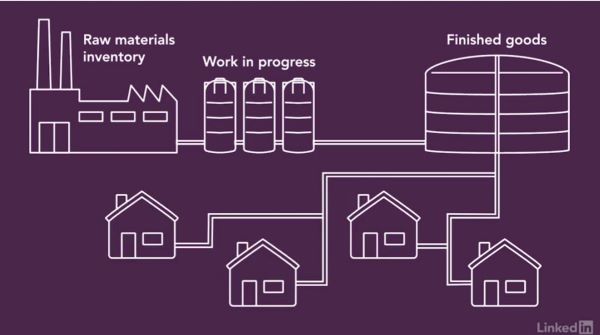In this article, we cover what pipeline inventory is and its importance. We also share our process for calculating pipeline inventory. Read on to learn more.

Pipeline Inventory is also known as "In-transit Inventory" or "Goods in Transit.” It denotes goods ordered by a company that are in the process of delivery or production but haven't reached the buyer's location yet. Essentially, it's stock that has left the seller but isn't yet with the buyer.
Example: Consider a scenario where a retailer orders a batch of t-shirts from a manufacturer. Once the t-shirts are shipped but have not yet reached the retailer's store, they are considered to be part of the retailer's pipeline inventory.

Pipeline inventory is crucial for a number of reasons. Some of these include:
Knowing your pipeline inventory can help businesses maintain optimal stock levels. If a business is aware of what's coming in, they can adjust their current storage needs and ensure they don't overstock or understock items.
Pipeline inventory represents a financial commitment. Goods that are in transit have usually been paid for but are not yet available for sale. By monitoring it, companies can optimize their cash flow and financial forecasts.
A consistent observation of the in-transit goods allows businesses to identify trends, predict future demands, and understand their lead times better. This, in turn, aids in effective procurement strategies.
Knowledge of pipeline inventory helps in managing risks related to supply chain disruptions. By being aware of potential delays or issues with incoming stock, companies can make proactive decisions to mitigate potential business impacts.
By understanding their pipeline inventory, companies can provide customers with more accurate estimates about product availability and delivery times to enhance customer satisfaction.

The calculation for pipeline inventory is relatively straightforward. Here’s our step-by-step process:
Begin by determining the average number of items or units that customers demand daily. This can be calculated by taking the total units sold over a specific period (e.g., a month) and dividing it by the number of days in that period.
Total Units Sold in Period / Number of Days in Period = Daily Demand Rate
Example: If a bookstore sold 300 books in the last 30 days, the daily demand rate would be:
Daily Demand Rate: 300 books / 30 days = 10 books/day
Lead time is the duration between when an order is placed and when it is received. It can be calculated in various units such as days, weeks, or months. For the purpose of calculating pipeline inventory, it's most commonly used in days.
Example: If the bookstore orders books from a publisher and it typically takes 5 days from order placement to delivery, then the lead time is 5 days.
Use the formula:
Pipeline Inventory = Daily Demand Rate × Lead Time
Multiply the daily demand rate by the lead time to get the pipeline inventory.
Example: Using the daily demand rate of 10 books/day and a lead time of 5 days:
Pipeline Inventory: 10 books/day × 5 days = 50 books
The resulting figure represents the number of units or items that are either in the process of being manufactured or are in transit at any given time. This value helps businesses plan for inventory storage, financial allocation, and risk management associated with in-transit goods.
Example: The resulting figure of 50 books means there are 50 books either being printed by the publisher or in transit to the bookstore at any given time. This number aids the bookstore in forecasting how many books they will soon have on hand.
Given that both demand rates and lead times can fluctuate, it's essential to regularly calculate pipeline inventory to ensure accuracy in inventory management.
Example: Suppose the next month, due to a promotional event, the daily demand rate at the bookstore rises to 15 books/day. The bookstore should then recalculate its pipeline inventory to adjust to this change in demand and ensure their stock levels and orders with the publisher are appropriately managed.
Java Bliss Roastery is a specialty coffee roasting company located in the heart of Seattle. They source rare coffee beans from various small-scale farmers globally and roast them in-house before selling to local cafes and customers online. Let's apply our pipeline inventory process to Java Bliss Roastery:
In the month of April, Java Bliss Roastery sold 3,000 pounds of roasted coffee beans to various cafes and online consumers.
Calculation: 3,000 pounds / 30 days = 100 pounds/day = Daily Demand Rate
When Java Bliss places an order for raw coffee beans from a farmer in Ethiopia, it takes, on average, 10 days for the beans to be harvested, packaged, and shipped to their roastery.
Result: The lead time is 10 days.
Java Bliss needs to understand how much coffee is either being processed or in transit at any given moment.
Calculation: 100 pounds/day × 10 days = 1,000 pounds = Pipeline Inventory
The 1,000 pounds figure indicates that at any given point, Java Bliss Roastery has about 1,000 pounds of coffee beans either being processed by farmers or in transit to their facility. This helps them manage storage space, anticipate financial outlays for incoming shipments, and mitigate potential risks, such as shipping delays.
In May, due to a surge in demand, Java Bliss's daily sales rise to 120 pounds/day. They must now adjust their pipeline inventory calculations to ensure they maintain optimal stock levels and don't face shortages.
Action: Java Bliss recalculates their pipeline inventory using the new daily demand rate to make any necessary adjustments in their orders and storage plans.
We hope you now have a better understanding of what pipeline inventory is and how to use our pipeline inventory calculation process.
If you enjoyed this article, you might also like our article on inventory waste or on hand inventory.